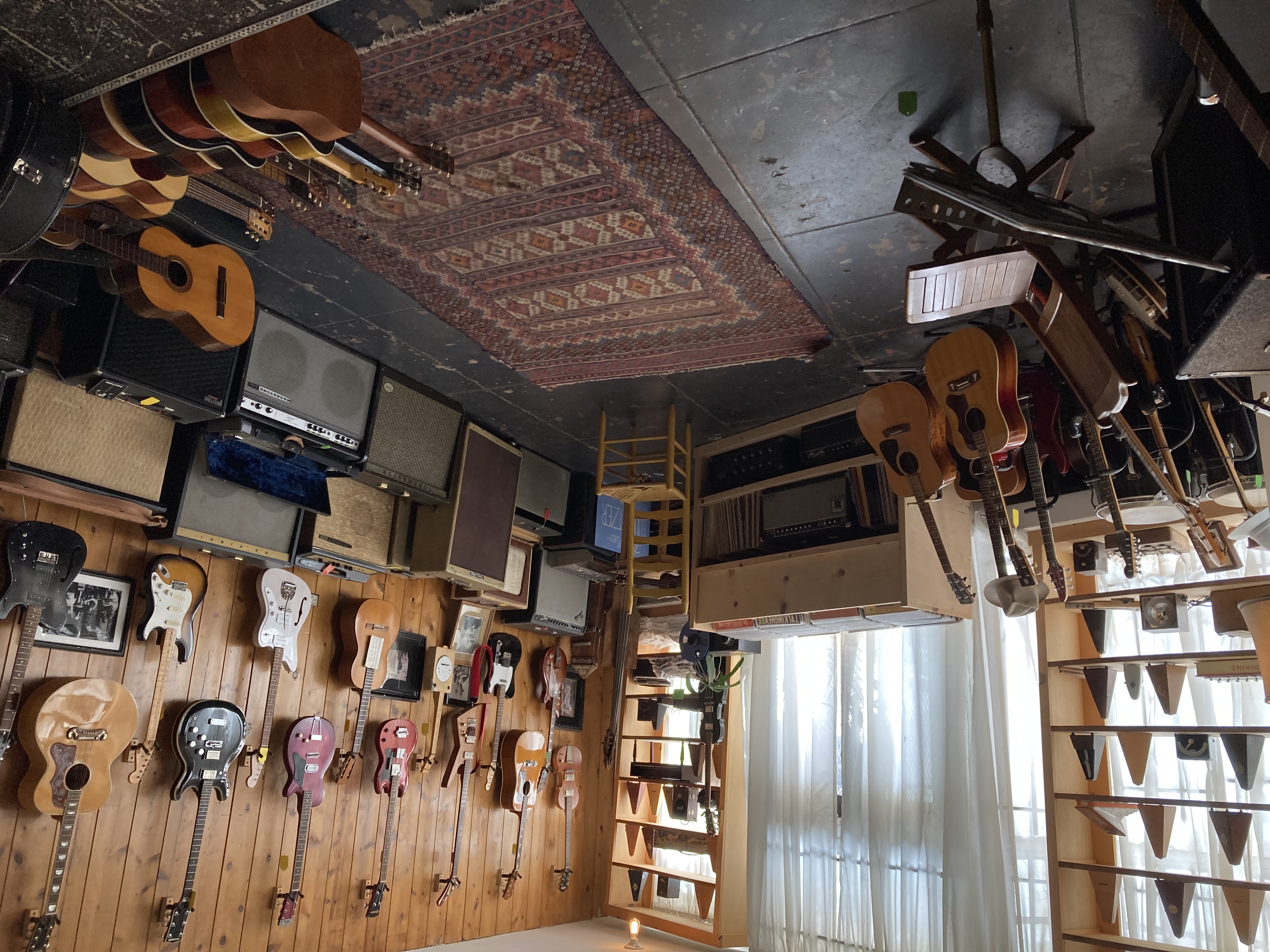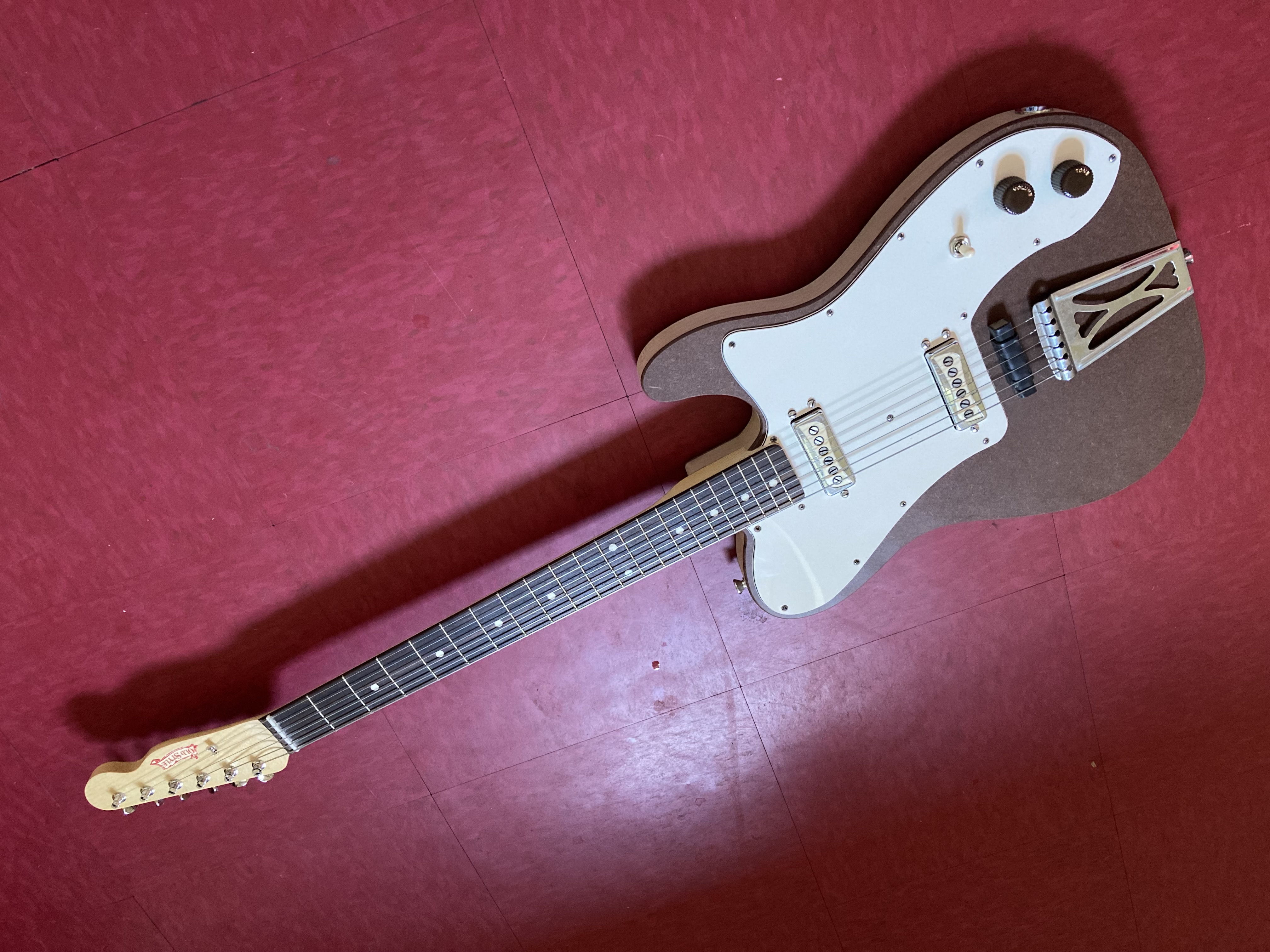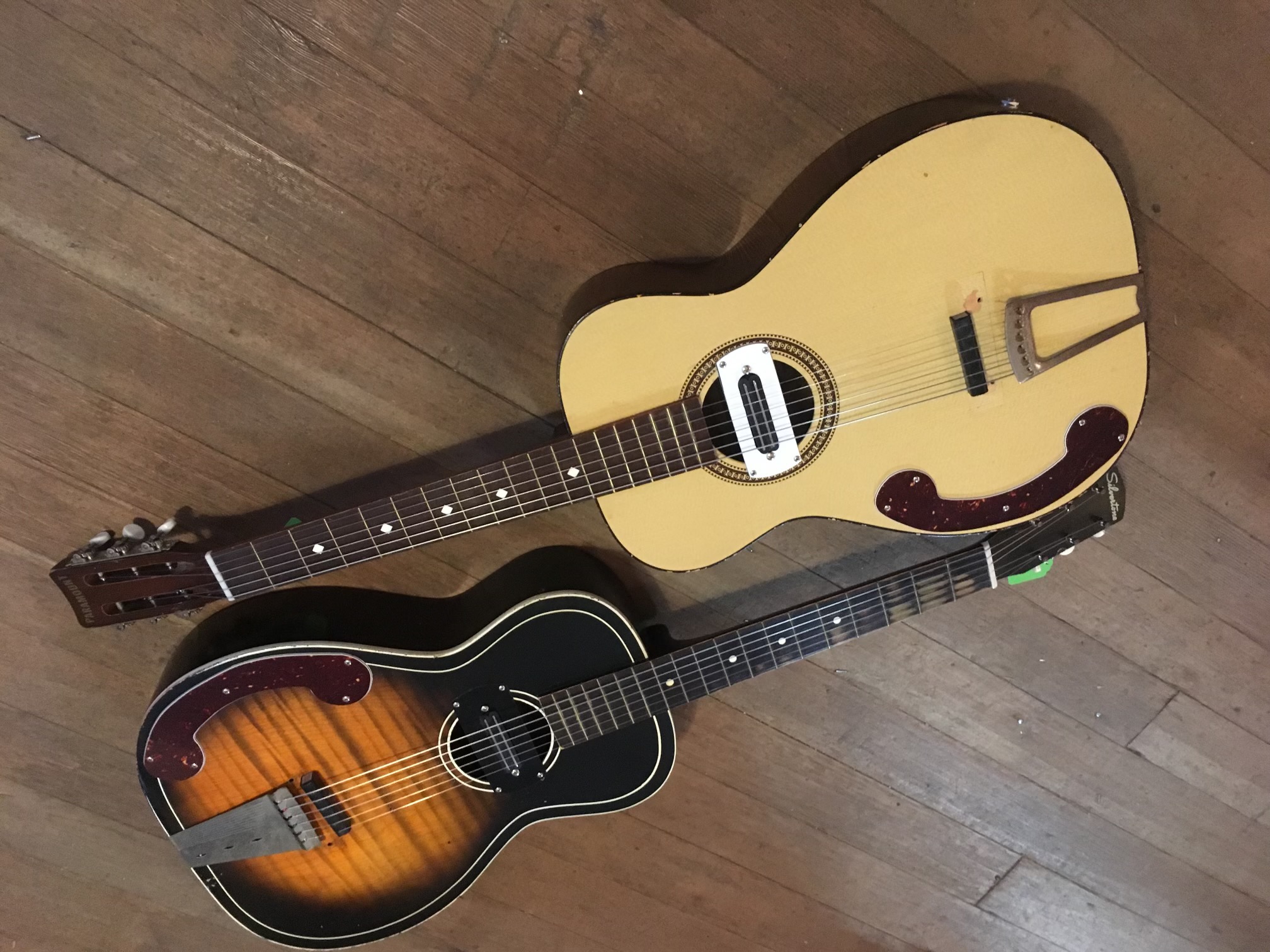Reuben Cox walked into Los Angeles' famed Sound City Studios, which bore timeless records like After the Goldrush and Fleetwood Mac , stunned to hear what he describes as "the most amazing sound [he's] ever heard." Still a haven for today's creators, the studio that day saw Blake Mills and producer Tony Berg working on Andrew Bird's 2016 record Are You Serious. Right away, Cox noticed something out of place—Mills, the guitar virtuoso, was tracking with a strange 1950s electric banjo that had a wood-and-metal wedge resting against the strings. Cox was mesmerized by the beauty of the unusual sound it created.
A day later, Cox, owner and luthier at the Old Style Guitar Shop, remained fixated on the sounds he had heard at Sound City. He stood at his worktable determined to recreate the mellow yet amplified sound of the banjo, but instead on Mills' primary instrument—a guitar. Scouring his shop for the right parts, he found a hollow plywood telecaster thinline body that he had built, threw an '80s Squier Bullet neck on it, and wrapped a '60s Japanese bridge in rubber from Home Depot. To amplify this muted sound, he installed a '70s Bill Lawrence pickup with a high output.
In just a few hours, Cox built the guitar and brought it to Mills at his home. It was the first of what would become a signature modification from Cox's Old Style Guitar Shop. In just a few years from this initial build, Cox's rubberized bridge guitars have proliferated throughout indie rock and into the highest realms of pop music.
His guitars are all over some of the hottest contemporary records—whether it's Phoebe Bridgers' Punisher, Taylor Swift's Folklore, Wilco's Ode to Joy, or Bob Dylan's Rough and Rowdy Ways. Taylor Swift and The National's Aaron Dessner mention the guitars in the Disney+ documentary Folklore: The Long Pond Studio Sessions, when Dessner recounts how he purchased one for Swift. The guitar "sounds really old and it just really kind of writes songs for you in a way," Dessner said.
So what is the appeal of rubber bridge guitars to artists and producers who have become obsessed? How does a photographer-turned-luthier end up as one of the most sought-after luthiers in Los Angeles? And—seeing as the guitars are kind of everywhere—why don't more people know about them?
The Start of Old Style & Rubber Bridge Builds
Reuben Cox relocated to Los Angeles, California, in 2009 and opened a guitar shop on a whim.
He was out with his daughter for a walk when he stumbled upon a "for rent" sign in front of a small and dusty store right off the 101. Rent in Silver Lake was cheap enough, the risk was low enough, and if he failed, he could revert to his previous career as a college-level photography teacher and editorial photographer for magazines. Here was a chance to run his own business, be his own boss, and live a charming Americana dream in a city with an unabashed competition for fame.
But this confidence was somewhat unwarranted; Cox didn't play much guitar and had minimal repair experience. His career as a photography professor at Cooper Union and Sarah Lawrence College gave him access to wood and metal shops, where he had built a few electric guitars as a hobbyist, but if someone handed him a holy-grail vintage guitar, could he be trusted? It's out of this necessity that Cox found his niche with inexpensive catalog guitars from the '50s and '60s.

Back in the mid-20th century, companies like Harmony, Kay, and Danelectro sold large amounts of guitars through catalogs and at Sears department stores. Because these guitars aren't sought-after in the way '50s Gibsons or '40s Martins are, they're an affordable option for those who want a vintage instrument but can't afford to spend top-dollar.
This low price point also made them the heart of Old Style's inventory—relatively risk-free canvases for Reuben's beginnings as a luthier and, later, his rubber bridge experiments. Beyond an eclectic collection of instruments, Old Style Guitar Shop remains different from the typical store, with no online retail option and a minimal social media presence.
While Reuben's first rubber bridge build was the Tele he gave to Mills at Sound City Studios, that was just the beginning of the guitar's life. The pair continued to tweak its pickups and controls.
"[Mills] likes to run down an idea till you can get the most of it," Cox says. "At first, it had just the neck pickup. Then, he wanted to try a bridge pickup, and we tried two or three bridge pickups, and then he wanted to move the volume and tone knobs closer to the strings so he could do pinky swells with the volume knob. There was this hole on the guitar, so I was like, 'Let's use it,' and I put a piezo mic inside."

A hot-output pickup plus the piezo mic proved to be a winning combination. Most of the rubber bridge guitars Cox has since built include both outputs.
"There's two pickups with the magnetic pickup and a second pickup—with its own quarter-inch output—is a disc piezo. People will either amplify both outputs, or DI both, and pan them a little bit," he says. "The main sound is the magnetic pickup, and the piezo is like a junky lo-fi sound. It makes sense to have them separate because these magnetic pickups and piezo mics, if you put them through the same circuit and put a three-way toggle on them, it sounds off."
Hacking away at a guitar while modding it is not for the faint of heart—nor, for that matter, precious vintage guitars. But with Old Style's inventory of department store models and Cox's own builds, there's freedom to experiment.
"If it were a Gibson or Fender guitar, it wouldn't be the best idea to start hacking into them and drilling extra holes into them, but during the folk boom in the '60s, there were so many guitars made. I think every man, woman, and child in America was required to own a guitar because of folk music. So many were manufactured," Cox says. "I mean, hopefully 50 years from now, people won't look back and be like, 'Gosh, this guy drilled all these holes in these guitars.'"
Word Gets Around
Reuben knows that people have made attempts at a muted sound for years, but his technique in wrapping the bridge in rubber creates a unique, ultra-muted sonic texture that has made the guitars more functional for the studio than some other types of mutes.

"I certainly didn't invent it. People have been using foam, tape, string, anything to get that sound. You hear it on a lot of songs, especially from the '60s because of the Fender Jaguars and Gretsch's that had a flip-up mute. Anyway, the vibe is the rubber bridge which mutes it, flatwound strings which are dark as well, and then you counteract that with a shredder pickup, basically so there's some clarity. That seems to be the combo," he says.
"The flip-up mutes or foam under the strings in front of the bridge, it sharpens everything. There's a lot of people who come through the shop and they're recording a lot—live, this matters less—but if you're recording out of tune, that's a problem. So for these, the mute is the bridge, and then also string-to-string balance is much more even than using foam, because the full downward pressure of the string is on the bridge. So it's like a variant of something that existed."
Cox's take on a muted sound caught on. At the same time that Mills and Cox were workshopping the rubber-bridge guitars, an existing relationship with The National gave Cox a line of feedback from musicians like Aaron Dessner, who would end up playing a rubber bridge Kay acoustic with Taylor Swift at the 2021 Grammy Awards. Word continued to spread about these guitars, reaching new artists.
A big collector is Wilco's Jeff Tweedy, well-known vintage gear enthusiast and now a professed lover of Reuben's rubber-bridge guitars.
"I first heard one of Reuben's rubber bridge guitars on a Perfume Genius song and was instantly drawn to it," Tweedy says. "I love old, duller strings and the rubber bridge was like an exaggeration of that. All tone with little overtones—and what overtone it does have are weird. No zing, no sustain. I've used a few of these guitars on tour and during the recording of Ode To Joy. He says, "Nels [Cline] has one, too. So does Pat [Sansone]."
Tweedy tells us he always has one nearby, whether he's writing songs or recording them. At this point, he now owns over a dozen rubber bridge guitars, with more in development for the band.
"Once I fell in love with their sound and Reuben's ability to make old student model guitars play well, I just kept asking to buy more," he says. "I think I have at least 12 or so now… and just recently got two rubber-bridge twelve-string guitars from Reuben. He's making me a rubber bridge Tele next, like the one they used in the Perfume Genius Tiny Desk concert."
Another fan is Madison Cunningham, best known for her songwriting and gritty guitar playing. Cunningham's producer Tyler Chester lent her a baritone Silvertone acoustic guitar with a rubber-bridge two years ago, and she still hasn't let it go. Ever since lockdown, Cunningham has found herself drawn to the rubber-bridge guitar and the creative freedom it enables.
"I couldn't put it down in the last year because it continues to be inspiring. You're forced to think differently when you play it and that's what I'm always looking for when I pick up a guitar," she says. "I think sometimes, picking up a jazzmaster or a tele, there's so many people that play it that you get in your head about how it ought to be played. The beauty of the rubber bridge is that you don't know how it's to be played, you just play it and find what works and it's exciting."
Cunningham describes the guitars as " beautiful leaders in a sonic situation," demonstrated by her performance of "When Love Loves Alone."
Each artist makes it clear that Reuben's guitars are packed with character that expand one's creative limits. Artist and Producer Ethan Gruska was overjoyed to speak about Reuben's work because of its impact on his music. In addition to writing and recording his own music, Gruska has produced records for Fiona Apple, Manchester Orchestra, and Phoebe Bridgers.
Gruska points to Phoebe Bridgers' second studio album, Punisher, nominated for four Grammys, as a strong feature of his instrument collection from Old Style. "I would say 80% of the acoustic guitars [on Punisher] are rubber-bridge guitars." He coins a new phrase to explain that "the most notable example on that record of Reubenisms is 'Garden Song.' Phoebe is playing a rubber bridge acoustic guitar—it's either a Kay or a Silvertone that's Tony Berg's at Sound City—and the warped, more electronic stuff is actually a rubber bridge 12-string guitar that we chopped up and made a more electronic-like sequence thing out of it. All the guitars on that song are Reuben-Specials."
Gruska shares one of his favorite recording techniques, made possible by the second input for the Piezo pickup. "Usually, for me, I do two DI lines and just do one with the neck and one in the Piezo and pan them really hard, and it becomes this beautiful, interesting stereo sound. The other great thing is plugging the piezo into an amp and the other line is just direct-in." He also finds use recording an acoustic sound with a microphone, adding that "there's just a lot of combinations."
To Wait or DIY in LA
Even if Reuben's guitars are on stage at the Grammys or featured on popular records, as a business owner and luthier, his operation is relatively small. There is currently a waitlist for custom-builds. Reuben insists that he will be "democratic and fulfill those in order."
If you're looking to skip a waitlist, there are several resources on the internet that teach you how to wrap a bridge in rubber. However, Reuben's biggest fans assure us that the magic goes beyond just a rubber bridge.
According to Gruska, "there's definitely ways to DIY it, and I think that's been going on a lot longer than his guitar, but he can figure out a way to make it play like a real, balanced instrument. It's intonated really well, it just… it feels right. I think that its craftsmanship makes it a really playable and standalone instrument."
Despite artists who sing his praise, Reuben is not one for the spotlight. He mentions several other repair techs and shop worthy of attention too: Colleen Fazio for amp repair in LA, Fanny's House of Music in Nashville, and Mamie Minch of Brooklyn Lutherie in New York City.
"It's really flattering that people have been using them," he says of his rubber bridge creations. "It's really fun to be an enabler, and since we're here in LA there's a lot of musicians who live here and come through here. I've gotten to know a lot of really great artists and put something like this in their hands. Ultimately, they're just incredibly cheap guitars and then these songs keep popping out of them for people."
